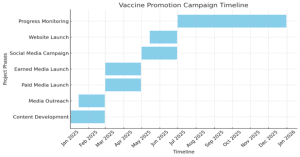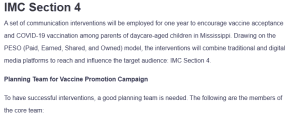IMC Section 4
A set of communication interventions will be employed for one year to encourage vaccine acceptance and COVID-19 vaccination among parents of daycare-aged children in Mississippi. Drawing on the PESO (Paid, Earned, Shared, and Owned) model, the interventions will combine traditional and digital media platforms to reach and influence the target audience: IMC Section 4.
Planning Team for Vaccine Promotion Campaign
To have successful interventions, a good planning team is needed. The following are the members of the core team:
- Emily Harris, Epidemiologist, Mississippi Department of Health (MDH) – As a public health expert, Dr. Harris will offer scientific direction to guarantee that the information provided to parents is precise and evidence-based.
- Jared Thomas, Media Relations Manager, Mississippi State Health Alliance (MSHA) – Jared will lead earned media initiatives, ensuring local media covers the campaign. He will build relationships with journalists to help draw attention to the vaccine.
- Maria Lopez, Social Media Coordinator, Parents for Healthy Kids – Maria will oversee social media campaigns, appealing directly to parents. Her skills will make the message sticky and suitable for electronic media such as Facebook and Instagram.
- Tina Patel, Director of Outreach, Mississippi Coalition for Children’s Health: Tina will ensure the campaign is tailored to the community’s needs and collaborate with local organizations to facilitate outreach efforts.
Communication Interventions
Paid Media Campaign
The initial intervention will be paid media on traditional media (radio, TV) and new media (Facebook, YouTube). The advertisements will involve healthcare providers discussing the safety and necessity of vaccinating children, as stipulated by Van Scoy et al. (2021). The advertisements will be targeted to parents in Mississippi and will work towards debunking prevalent vaccine myths.
Outcome Objective
To raise vaccination levels by 15% in 6 months (August 2025). Local vaccination levels will measure this.
Earned Media Coverage
The second intervention will use earned media to establish credibility, including interviews and stories with health experts. Local media will cover the campaign to give vaccine-hesitant parents credible information.
Outcome Objective
Obtain a 20% rise in media coverage of the COVID-19 vaccine within 3 months. Media coverage will be monitored with the assistance of media tracking tools.
Shared Media on Social Platforms
Social media websites will communicate with parents via posts, videos, and live Q&As with healthcare professionals (Olson et al., 2020). The intervention will create an online support group for parents and facilitate conversations regarding vaccination.
Outcome Objective
Record 30,000 social media interactions (likes, shares, comments) in 6 months. Engagement metrics will monitor success.
Owned Media (Website and Email Campaign)
A dedicated website will be developed as a one-stop information resource for the COVID-19 vaccine. The website will have FAQs, videos of experts, and a vaccine locator. Parents will also receive weekly email newsletters to keep them engaged and informed.
Outcome Objective
To drive a 50% increase in website traffic within 4 months, with a minimum of 5,000 parents opting for the email campaign. It will be measured using web analytics.
Program Plan, Timeline, and Budget
The campaign budget is $100,000, which will be used for media buys, content development, and personnel salaries. The campaign lasts for a year:
- Months 1-2: Develop content and approach media.
- Months 3-4: Paid media and earned media campaigns start.
- Months 5-6: Social media campaigns and website launch.
- Months 7-12: Track progress, refine strategies, and assess impact.
| Item | Estimated Cost | Notes |
| Paid Media (TV, Radio, Facebook Ads) | $30,000 | Budget for media buys, advertisements, and content creation. |
| Earned Media (Interviews, Stories) | $10,000 | Costs for media outreach and press materials. |
| Social Media Campaigns | $15,000 | Includes content creation, ad spending, and influencer partnerships. |
| Website Development & Hosting | $5,000 | Includes design, hosting fees, and maintenance for the campaign site. |
| Email Campaign | $2,000 | Email platform subscription and design costs for newsletters. |
| Event Costs (Workshops, Meetings) | $3,000 | Venue, catering, and materials for workshops with parents. |
| Outreach Materials (Flyers, Brochures) | $3,000 | Printing and distribution of outreach materials in local communities. |

Conclusion
Using these four communication interventions, the campaign aims to enhance vaccine uptake in daycare-aged children in Mississippi. By utilizing a combined media approach and collaboration with the major stakeholders, the program will ensure vaccine hesitancy is subdued and the community’s health is protected.
References
Olson, O., Berry, C., & Kumar, N. (2020). Addressing parental vaccine hesitancy towards childhood vaccines in the United States: A systematic literature review of communication interventions and strategies. Vaccines, 8(4), 590. https://doi.org/10.3390/vaccines8040590
Van Scoy, L. J., Snyder, B., Miller, E. L., Toyobo, O., Grewel, A., Ha, G., Gillespie, S., Patel, M., Reilly, J., Zgierska, A. E., & Lennon, R. P. (2021). Public anxiety and distrust due to perceived politicization and media sensationalism during early COVID-19 media messaging. Journal of Communication in Healthcare, 14(3), 193–205. https://doi.org/10.1080/17538068.2021.1953934
ORDER A PLAGIARISM-FREE PAPER HERE
We’ll write everything from scratch
Question 
What it is: Interventions are methods used to influence, facilitate or promote behavior change (e.g., holding training classes to help seniors start their own walking clubs, developing a Website to promote drug-free activities to youth, expanding clinic hours to improve working mothers’ access to HIV testing).How it is Done
- Select members and assign roles for your (hypothetical) planning team.
- Assemble the strongest planning team you can. In addition to representatives of the groups you want to reach, it should include members whose combined experience ensures that the necessary technical, managerial, and creative contributions will be made.
- Be sure your team continues to include members of your target audience—they know best what will and won’t work. The perspective of the local service providers who will deliver the interventions should also be represented. While you won’t really be assembling a team for this hypothetical project, consider who would make up your “dream team” to promote your vaccine in the state of MS. List their names/titles/organizations, and why you chose them. 4-5 people should be sufficient!
- Write specific, measurable objectives for each of the 4 intervention activities created in the last section.
- Outcome objectives specify the kind and amount of change you expect to achieve for a specific population within a given time frame for each intervention. Remember, behavior change takes a long time.
- Begin with an outcome objective that quantifies the desired behavior change. Then estimate the amount of change that would be necessary in each target segment thinks, feels, knows, intends, and does to reach the ultimate behavioral objective.
- For the outcome and each of its determinants, specify:
- Who specifically will be affected?
- What will change?
- How much change will occur? (include a metric)
- By when? (Specific DATE)
- Make sure your outcome objectives are “SMART.”
- Specific
- Measurable
- Achievable
- Relevant
- Time-specific
- Write a program plan, including timeline and budget, which encompasses each intervention.
- The program plan should include:
- specific activities
- SMART objectives
- a timeline
- a detailed budget
- Social Marketing interventions tend to take four forms, reflecting the strategy used to achieve the desired outcomes:
- Service interventions- create or modify services, tests, or treatments to improve health.
- For example, you might co-locate barber shops and blood-pressure screening clinic services for African-American men.
- Product interventions- create or modify a product that promotes health.
- For example, you repackage a nicotine replacement device so that it can be distributed through vending machines at bars.
- Policy interventions- lead to regulatory, legislative, or organizational rulings that supports improvements in the public’s health.
- For example, your coalition might be successful in advocating for city funding for bike lanes.
- Communication interventions- inform and influence individual and community decisions about behavior that enhances health.
- For example, a radio soap opera might persuade women to discuss condoms with male sex partners
- The program plan should include:
**THIS project should include 4 COMMUNICATION interventions, which align with the PESO Model. Be sure to consider both traditional media (e.g., newspapers, radio, TV, magazines, etc) and digital/social media. This is maximizing/best utilizing the full IMC mix.
*You can also include one of any of the other types of interventions for extra credit–but it is not required. If you do include the extra credit intervention, be sure to label it as such! You will be awarded 5 additional points on your final project.

IMC Section 4
- Working backward from your outcome objectives, develop a timeline that covers all phases of each intervention. Include key deadlines, milestones. The timeline is central to your program plan. Include launch schedules into your timeline as well. Select or create a graphic that is easy for all partners to understand and makes sense for your goals and objectives.
- A Gantt chart (https://www.teamgantt.com/
free-gantt-chart-excel- ) is one way to display your timeline.template
Budget- Your budget, for the purposes of this project, is $100,000.
- Budgets should be “built,” on the basis of the activities and materials necessary for the interventions. Keep your objectives in mind as you decided whether the costs of specific activities are justified. If necessary, build your budget so that it tracks separate funding streams. Your budget should specify resources including:
- donated products and services
- volunteer time
- in-kind contributions
- matching contributions◘
- Your budget should cover all the costs or expenses of the intervention activities and should be formatted as follows:
![]()
Create 1 visual for your project, in addition to the timeline and budget, which do not count as a separate visual. The sky is the limit on your visual (e.g., important graph about vaccine trends, infographic, etc). Insert this into the “interventions” section of your final project.